REST
The REST outbound adapter in Connxio facilitates integration with external systems through RESTful APIs. It provides users with the ability to send data, messages, and payloads to REST endpoints. With this adapter, users can establish connections with various systems and services that support REST APIs.
Limitations
When choosing between the REST adapter and an asynchronous adapter in Connxio, users should be aware of the following considerations. The REST adapter offers immediate error responses, allowing for quick feedback and troubleshooting. However, it relies on the availability of the receiving system for uptime. In contrast, the asynchronous adapter provides increased uptime and fault tolerance, ensuring message delivery even during system outages. Users should evaluate their integration requirements, responsiveness needs, and the receiving system's availability when selecting the appropriate adapter in Connxio.
Configuring the REST adapter
To configure Connxio to start sending data to a REST endpoint select the "REST" option in the "Outbound Connections" shape:
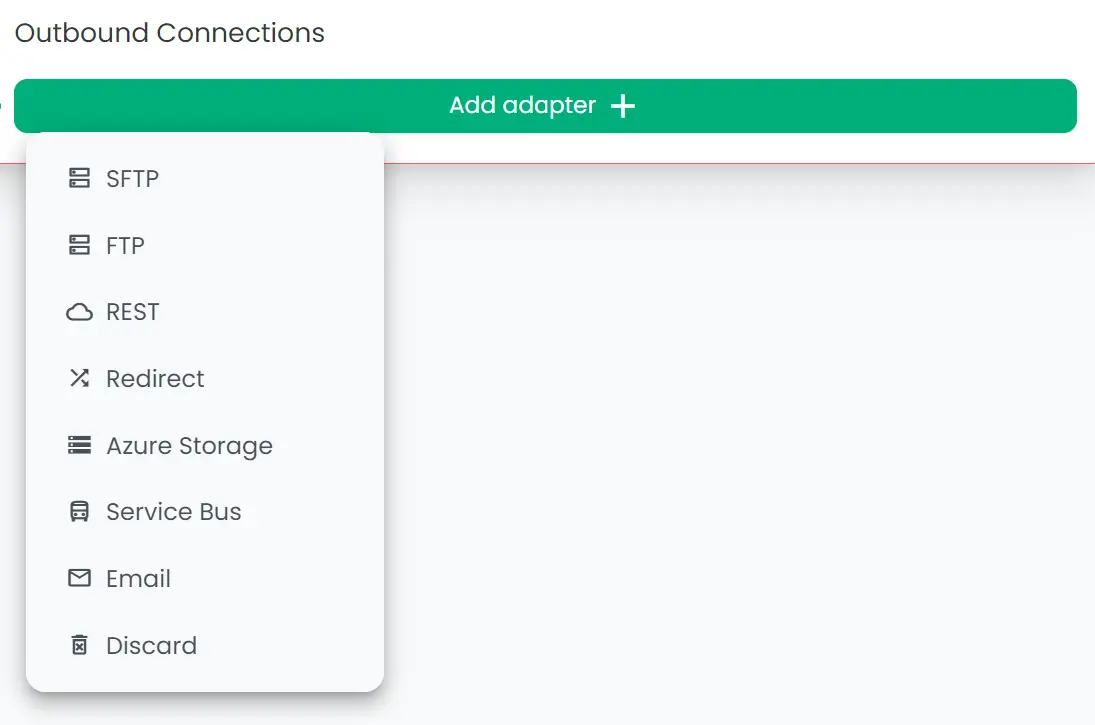
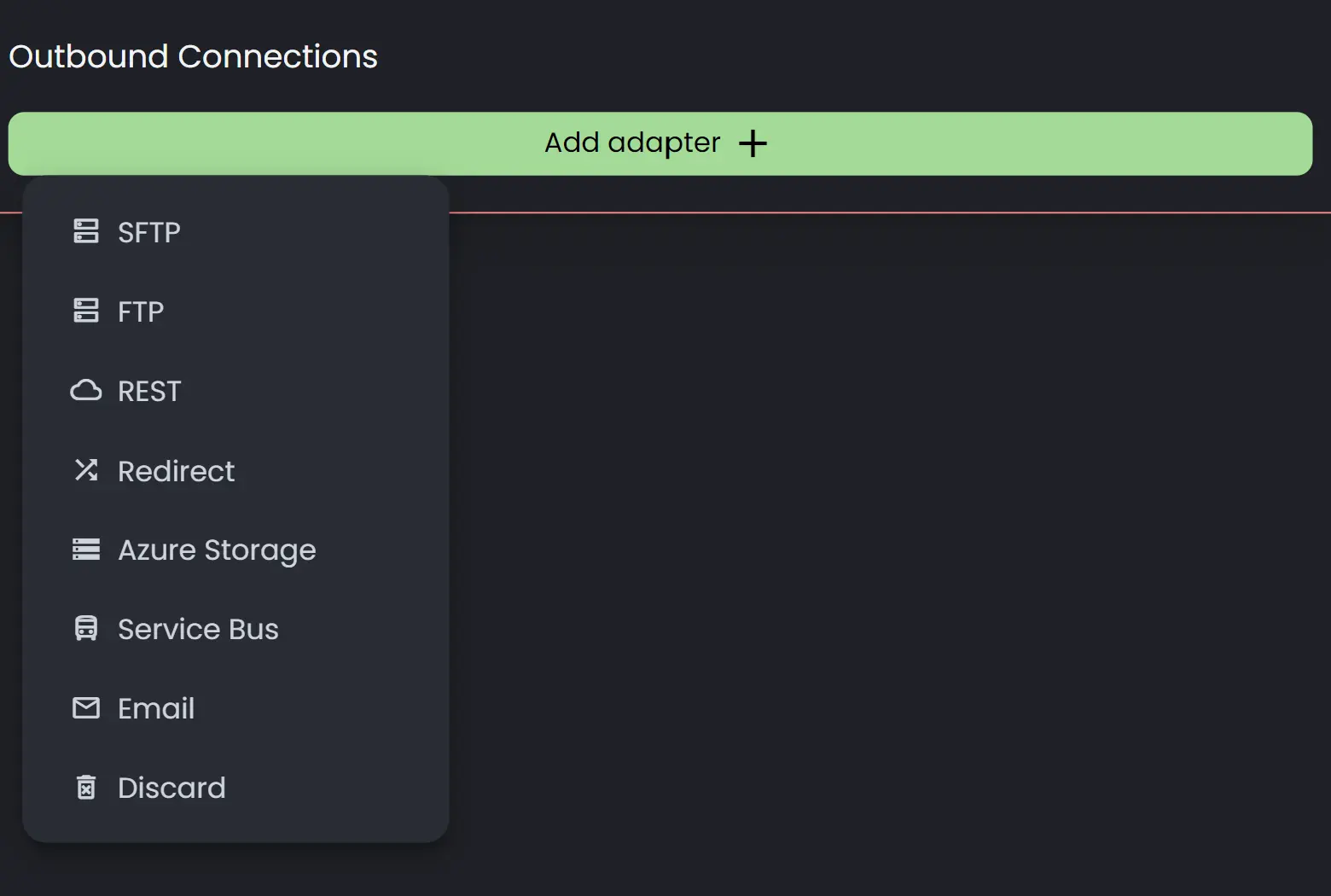
On creating a new adapter, a popup with the adapter's input fields will appear. Email has 4 sections; Adapter name, Acknowledgement settings, Core settings and Advanced settings.
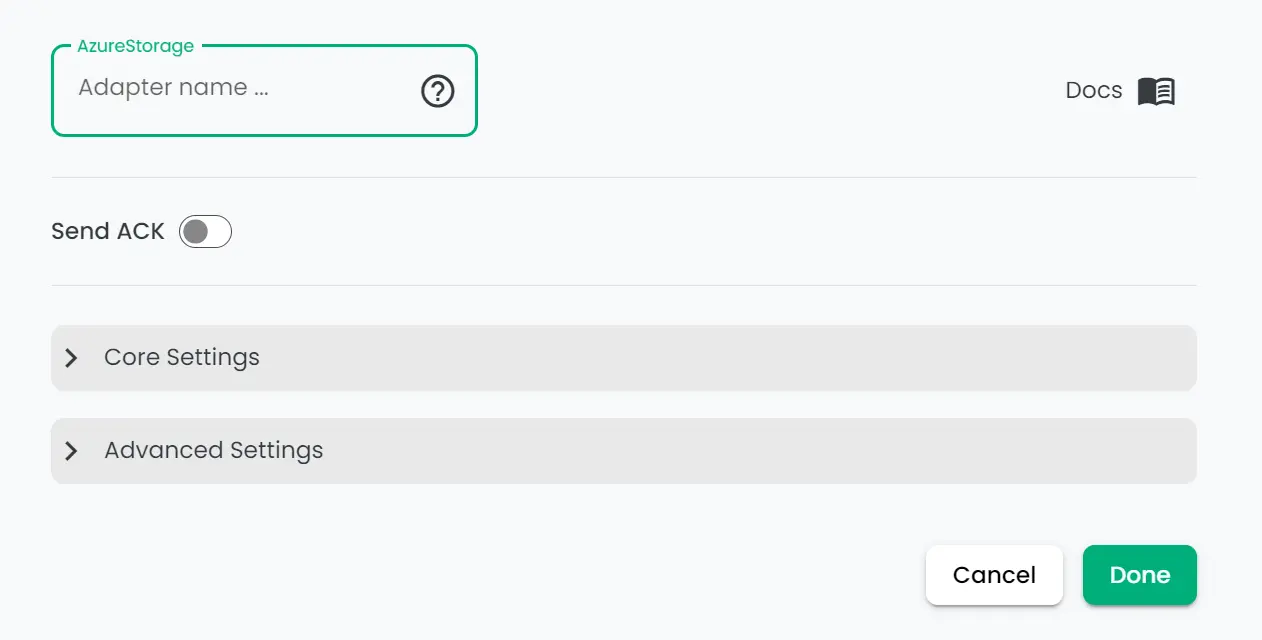
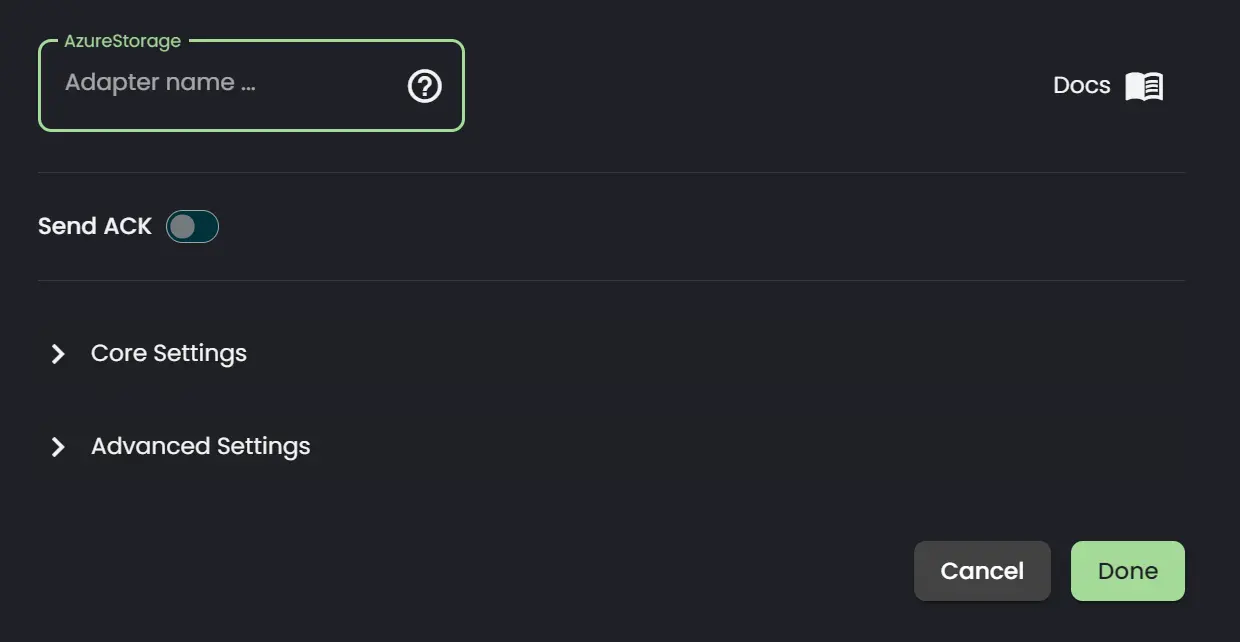
Read more about the properties in each section below:
Adaptername & Ack
- Adapter Name: The logical name of the adapter. This is shown in outbound adapter list in the subintegration view.
- Send Acknowledgement: Is explained here.
Core settings


-
Method: The HTTP verb to use when contacting the restful endpoint.
-
Endpoint Url: The URL of the endpoint.
-
Security Configuration/Authorization: The security configuration to use for authenticating the request.
-
Headers: Add headers here as necessary to either authenticate the request or add other needed parameters.


-
Advanced Error Handling: Advanced error handling allows you to create rules for handling specific unsuccessful status codes beyond the standard pattern. Read more about it below
Batch processing
This adapter support Batch Processing. Contrary to non-batch processing the batch processing pipeline batches messages before sending them to the receiver. This can be helpful in several scenarios. The actual usefulness and implementation varies from adapter to adapter.
For the Rest adapter, Batch Processing is the act of batching messages before sending them to ensure semi-ordered delivery of said messages. We call it semi-ordered because ordering is not enforced from the inbound pipeline and all the way through the CX pipeline, but rather only on the outbound adapter step. This means that messages will be unordered, and can arrive in any random order, but will be delivered one after another in an ordered fashion.
By using the supplied values on the rest adapter in the Batch Processing section you can change the batching behavior.
The point of batching messages before delivery is to slow down CX outbound delivery. Many apps don't have the capability to receive as many requests as CX is able to send at once with our heavy parallelization.
How it works
Batching for the Rest adapter works like this:
- Message is processed through the CX pipeline as normal and arrives in a queue that corresponds to the adapter used.
- The outbound engine scans the queue every time the Cron Expression hits and gets the amount of messages specified in the Batch size parameter, or less iof there aren't enough on the queue.
- The messages are processed and sent one after the other. New batches are prevented from loading as long as the current batch is being processed. If the receiver is slow this can result in the batch taking a long time, as latency for every message will compound. We recommend setting the Batch Size and Cron Expression accordingly to avoid very slow and large batches. The exact configuration combination that enables the best performance for your scenario is only known by testing the endpoint with a diverse set of options.
- If a message fails it is not marked as failing and added to the failure handling system util the batch has finished. Be aware that exceptionally large and long lasting batches may time out.
Configuring Batch Processing

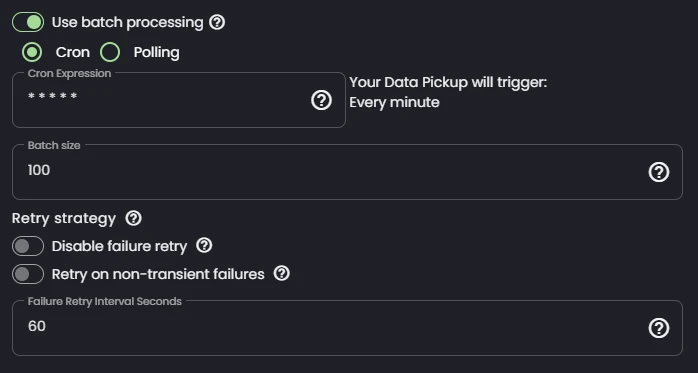
- Cron Expression: Specifies the frequency at which the batching operation is triggered. Read more about the triggering interval here.
- Batch Size: The size of a batch to get from the queue every interval.
- Disable Failure Retry: Toggles the retry. The batching will run on its normal schedule even on errors.
- Retry on non-transient failures: Retry on all errors, even those that are labeled as non-retryable.
- Failure Retry Interval Seconds: Sets the interval in seconds for retries after batching error. This overrides the Cron and Polling interval on an error. Minimum value is 60 seconds.
Advanced settings


- Duplicate Detection: Terminate the message if the exact same has been processed any time the last five days. Connxio does not guarantee that no duplicates will be sent.
- Termination Status: The status used for logged in when a duplicate is terminated. If left empty, the status will default to 'Terminated'
Extending Logging
Connxio will add an InterchangeId header to the outgoing request to facilitate for continued transactional logging on the receiver side.
If you need to receive the InterchangeId by other means we recommend either including it in the message by using transformations or adding the InterchangeId as a query parameter with Connxio Macro Language.
E.g.:
http://www.myapi.com?InterchangeId={interchange}
Advanced error handling


By default, all failed REST requests will be retried according to the retry pattern. If the request is still not successful, the transaction will be logged as an error and terminated. Advanced error handling allows you to create rules for handling specific unsuccessful status codes beyond the standard pattern.
| Input | Type | Description |
|---|---|---|
| Status codes | int , - | A comma-separated list of status codes on which the rule should act. A range of status codes can be defined by using '-', for instance, 401-408 will represent all status codes from and including 401 to and including 408. |
| Action | Terminate, Redirect to secondary | "Terminate" stops the transaction, while "Redirect to secondary" redirects the request to the Fallback adapter and makes one attempt to make the request. If this request fails, the transaction will be terminated and logged as "Error" unless something else is defined in the "Custom status" field |
| Custom status | string | By default all transactions will be logged as "Error". This property overrides the default status. |
| Retry | true, false | If disabled, no retry attempts will be made and the Rule Action will trigger immediately. If enabled, the default retry pattern will run before the Rule Action triggers. |
Fallback

Fallback lets you react to errors by handling errors with external services or logging. By enabling this functionality you specify an endpoint that can be used to react to events, terminate the process or retry it through a backup endpoint. The message will be completed and logged as successfully if the endpoint return a success 2xx status code. If a non success status code is returned the message will be retried as described in the retry section.
An example of how this functionality can be useful is to configure a fallback endpoint thats in another region or on another platform that can process requests when the main service is down. Another example could be an endpoint that puts messages back into a queue or backup pipeline that holds the message for future processing. The examples are more or less endless and fallback could be used for most critical RESTful endpoint.
Retry
When handling RESTful communication a set of status codes are defined. We handle the ones in the list below. Be aware that all status codes not handles here defaults to no retry unless fallback is set. All retry is handled as backoff retry with endpoint retry or with endpoint retry only, read more about retry on the Retry page.
| Status Code | Description | Retry Action |
|---|---|---|
| 400 | Bad Request | Is not retried. Not retried because payload does not change on each retry. |
| 404 | Not Found | Is not retried. Something was not found while processing data, stop processing since this will not change. |
| 408 | Request Timeout | Is retried with endpoint retry only |
| 409 | Conflict | Is not retried. There are conflicts in the current state, this is not expected to change on retry. |
| 429 | Too Many Requests | Is retried with endpoint retry only |
| 500 | Internal Server Error | Is retried with both backoff and endpoint retry. We have chosen to include 500 in retry as this is the default code for unhandled exceptions, and since this is the most common code received on connection issues inside external endpoints. |
| 502 | Bad Gateway | Is retried with both backoff and endpoint retry |
| 503 | Service Unavailable | Is retried with both backoff and endpoint retry |
| 504 | Gateway Timeout | Is retried with endpoint retry only |
We also have special handling on some network issues. You might see references in error logs to the exception type as described below. This list does not describe all actions taken to ensure message delivery stability but describes the errors usually seen by customers:
| Network Issue | Description | Retry Action | Customer Action |
|---|---|---|---|
| AuthenticationException | Describes issues with SSL certificates and other formal security issues | Is not retried since fault correction requires formal changes to authentication. | Please check you ssl certificates or other endpoint security and verify that everything is valid. Turning off message intake might be a good idea to stop error spam. |
| HttpRequestException | Describes issues with underlying protocols and network infrastructure. | Is retried with backoff since the issue is usually transient. AuthenticationException is a subset of this issue and handled separately. | If retry fails please review logs from your logging provider and make changes as necessary. Turning off message intake might be a good idea if possible to stop error spam. |
| TaskCanceledException | Describes issues with external endpoint taking too long to respond and Connxio closing the connection. | Uses backoff retry only. Retrying canceled requests can be dangerous if the receiving endpoint is not idempotent. Please contact us if you have problems with these kinds of issues and have a non idempotent endpoint. | If retry fails please review error logs from your logging provider and make changes as necessary. Be aware that the message could be delivered multiple times when the task is canceled and check your receiving database for duplicates. Turning off message intake might be a good idea if possible to stop error spam if retry has not handled the error. |
| SocketException | Describes issues the established connection, usually happens when connections close unexpectedly because of timeouts on the endpoint side. | Uses backoff retry only. | If retry fails please review error logs from your logging provider and make changes as necessary. Turning off message intake might be a good idea if possible to stop error spam if retry has not handled the error. |
| SocketException | Describes issues the established connection, usually happens when connections close unexpectedly because of timeouts on the endpoint side. | Uses backoff retry only. | If retry fails please review error logs from your logging provider and make changes as necessary. Turning off message intake might be a good idea if possible to stop error spam if retry has not handled the error. |
| IOException | Describes issues related to http communication that does not fit a narrower category. | Uses backoff retry only. | If retry fails please review error logs from your logging provider and make changes as necessary. Turning off message intake might be a good idea if possible to stop error spam if retry has not handled the error. |
Receive content as bytes
When using the "Handle File As Binary" option you have to receive the payload as an application/octet-stream as Connxio sends the content as bytes. The whole body of the request is your content as usual for Connxio payloads.
The easiest way to receive bytes as body in a C# API is to receive the body directly. Below is an example of this method:
[HttpPost]
public async Task<IActionResult> Post()
{
byte[] contentBytes;
using (var memoryStream = new MemoryStream())
{
await Request.Body.CopyToAsync(memoryStream);
contentBytes = memoryStream.ToArray();
}
// Do something
return Ok("foo bar");
}
Note that this method requires you to not receive anything in the controller method.
The other option is to create your own InputFormatter, this tells the model-binder how to handle binary content and receives it as a byte[] directly. Below is an example of the InputFormatter in question:
public class BinaryInputFormatter : InputFormatter
{
const string binaryContentType = "application/octet-stream";
const int bufferLength = 16384;
public BinaryInputFormatter()
{
SupportedMediaTypes.Add(MediaTypeHeaderValue.Parse(binaryContentType));
}
public async override Task<InputFormatterResult> ReadRequestBodyAsync(InputFormatterContext context)
{
using (MemoryStream ms = new MemoryStream(bufferLength))
{
await context.HttpContext.Request.Body.CopyToAsync(ms);
object result = ms.ToArray();
return await InputFormatterResult.SuccessAsync(result);
}
}
protected override bool CanReadType(Type type)
{
if (type == typeof(byte[]))
return true;
else
return false;
}
}
Add the formatter to your startup. For .net core this is done in the AddMvc method, this may vary for other .net frameworks.
When the InputFormatter is added you simply receive the content as byte[] in your controller.